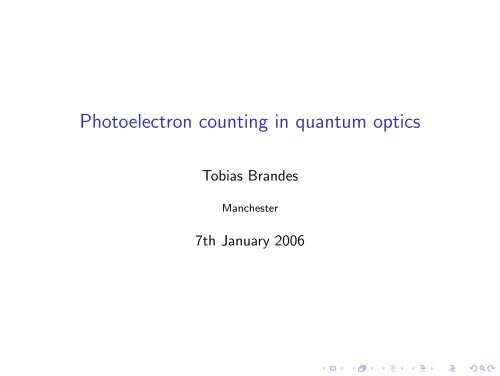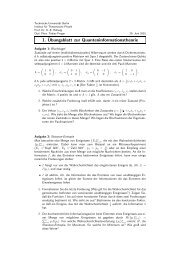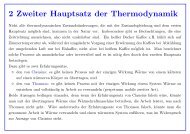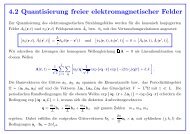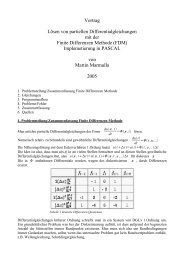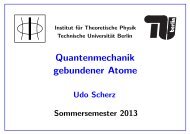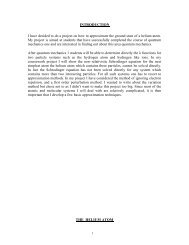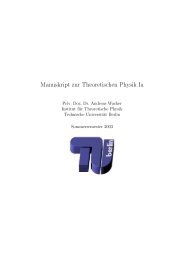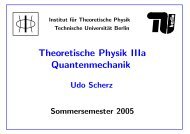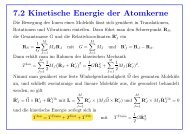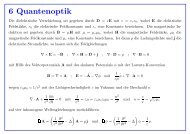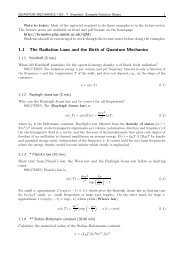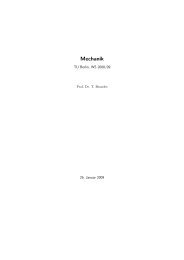Photoelectron counting in quantum optics
Photoelectron counting in quantum optics
Photoelectron counting in quantum optics
You also want an ePaper? Increase the reach of your titles
YUMPU automatically turns print PDFs into web optimized ePapers that Google loves.
<strong>Photoelectron</strong> <strong>count<strong>in</strong>g</strong> <strong>in</strong> <strong>quantum</strong> <strong>optics</strong>Tobias BrandesManchester7th January 2006
1 Introduction2 Photoelectric <strong>count<strong>in</strong>g</strong>: classical fieldMandel formula3 Photo-count formula <strong>in</strong> <strong>quantum</strong> <strong>optics</strong>Mandel formula generalisation: discussion4 Some <strong>quantum</strong> <strong>optics</strong> techniquesMaster equations and <strong>quantum</strong> dissipationApplication: microscopic field-detector theoryQuantum <strong>optics</strong> techniques: P-representation
Overview: photons, photon-<strong>count<strong>in</strong>g</strong>, fluctuationsCount<strong>in</strong>g photonsCount<strong>in</strong>g photons, but......‘the eternal question: what is a photon’.‘What is light ?’
Overview: photons, photon-<strong>count<strong>in</strong>g</strong>, fluctuationsCount<strong>in</strong>g photonsCount<strong>in</strong>g photons, but......‘the eternal question: what is a photon’.‘What is light ?’E<strong>in</strong>ste<strong>in</strong> 1951: ‘...these days everyfool pretends to know what a photonis. I have been th<strong>in</strong>k<strong>in</strong>g about thisfor the whole of my life, and Ihaven’t found the answer‘.
Overview: photons, photon-<strong>count<strong>in</strong>g</strong>, fluctuationsCount<strong>in</strong>g photonsCount<strong>in</strong>g photons, but......‘the eternal question: what is a photon’.‘What is light ?’E<strong>in</strong>ste<strong>in</strong> 1951: ‘...these days everyfool pretends to know what a photonis. I have been th<strong>in</strong>k<strong>in</strong>g about thisfor the whole of my life, and Ihaven’t found the answer‘....cavity mode H = ωa † a, n-photon eigenstate |n〉.
Overview: photons, photon-<strong>count<strong>in</strong>g</strong>, fluctuationsCount<strong>in</strong>g photonsCount<strong>in</strong>g photons, but......‘the eternal question: what is a photon’.‘What is light ?’E<strong>in</strong>ste<strong>in</strong> 1951: ‘...these days everyfool pretends to know what a photonis. I have been th<strong>in</strong>k<strong>in</strong>g about thisfor the whole of my life, and Ihaven’t found the answer‘....cavity mode H = ωa † a, n-photon eigenstate |n〉....photon as gauge-boson of QED .
Overview: photons, photon-<strong>count<strong>in</strong>g</strong>, fluctuationsIrony of history: <strong>quantum</strong> mechanics‘No photons’ for thephotoelectric effect.Quantum mechanics wasdiscovered <strong>in</strong> its own classicallimit.
Overview: photons, photon-<strong>count<strong>in</strong>g</strong>, fluctuationsPhoton <strong>count<strong>in</strong>g</strong>: some issuesCount photo-electrons <strong>in</strong>stead of photons.Count<strong>in</strong>g statistics: correct theory forp n (t, t + T ) probability for n photo-electrons <strong>in</strong> [t, t + T ).Detector back-action. System-bath problem ‘with two baths’.... no entirely trivial!
Semiclassical theory for p n (t, t + T ): Mandel formulaPhotodetector model: ionize s<strong>in</strong>gle atomClassical electromagnetic field,vector potentialA(r)e −iωt + A ∗ (r)e iωt .Probability p 1 (t, t + ∆t) of one count: Fermi’s Golden Rulep 1 (t, t + ∆t) =∫ ∞0∣dEν(E) ∣〈E| e m pA(r)|E 0〉 ∣ 2 D ∆t (E − E 0 − ω)= ηI (r)∆t, I (r) = |A(r)| 2 (<strong>in</strong>tensity). (1)D ∆t (ε) ≡ ( [s<strong>in</strong> 1 2 ε∆t]/[ 1 2 ε]) 2 , ∆t → 0. Polarisation A(r) = ⃗εA(r).
Mandel formula: many countsHow to obta<strong>in</strong> probability of n transitions p n (t, t + T )Short-time probability p 1 (t, t + ∆t) = ηI (r)∆t for s<strong>in</strong>gle electrontransition (ηI (r) transition rate).Long-time probability of n transitions p n (t, t + T ) ↔ n electrons.Individual transitions are statistically <strong>in</strong>dependent... Poisson distribution.Characterized by average ¯n only p n (t, t + T ) = ¯nnn! e−¯n , ¯n = ηI (r)T . (2)
Mandel formula: many countsHow to obta<strong>in</strong> probability of n transitions p n (t, t + T )Short-time probability p 1 (t, t + ∆t) = ηI (r)∆t for s<strong>in</strong>gle electrontransition (ηI (r) transition rate).Long-time probability of n transitions p n (t, t + T ) ↔ n electrons.Markovian master equation for probabilities. p n (t) ≡ p n (0, t),p n (t + dt) = p n (t) × [1 − ηI (r)dt] + p n−1 (t) × ηI (r)dt (2)ddt p n(t) = ηI (r)[p n−1 (t) − p n (t)]. (3)Generat<strong>in</strong>g function G(s, t) ≡ ∑ ∞n=0 sn p n (t),∂ t G(s, t) = ηI (r)(s − 1)G(s, t).Solve with p 0 (0) = 1, p n (0) = 0, n > 0, G(s, 0) = 1.Thus G(s, t) = exp[ηI (r)t(s − 1)] = ∑ ∞ ¯nnn=0snn! e−¯n , ¯n = ηI (r)t.
Mandel formula: many countsHow to obta<strong>in</strong> probability of n transitions p n (t, t + T )Short-time probability p 1 (t, t + ∆t) = ηI (r)∆t for s<strong>in</strong>gle electrontransition (ηI (r) transition rate).Long-time probability of n transitions p n (t, t + T ) ↔ n electrons.SUMMARY so far:Classical photo-electron <strong>count<strong>in</strong>g</strong> formula (Mandel formula)Poisson process.p n (t, t + T ) = ¯nnn! e−¯n , ¯n = ηI (r)T .Generat<strong>in</strong>g function G(s, t) ≡ ∑ ∞n=0 sn p n (t) = exp[ηI (r)t(s − 1)].Noth<strong>in</strong>g said here about PHOTONS! This is a DETECTOR theory.
‘Quantum Mandel formulas’Kelley-Kle<strong>in</strong>er, Carmichael, etc. versionp n (t, t + T ) = 〈: ˆΩ nn! e−ˆΩ :〉 with ˆΩ ≡ ξ ∫ t+Ttdt ′ Ê − (t ′ )Ê + (t ′ ).No backaction of detector on field.‘Non-absorbed photons escape, open system.’Typically many field degrees of freedom, field is a ‘BIG QUANTUMSYSTEM’.
‘Quantum Mandel formulas’Kelley-Kle<strong>in</strong>er, Carmichael, etc. versionp n (t, t + T ) = 〈: ˆΩ nn! e−ˆΩ :〉 with ˆΩ ≡ ξ ∫ t+Ttdt ′ Ê − (t ′ )Ê + (t ′ ).No backaction of detector on field.‘Non-absorbed photons escape, open system.’Typically many field degrees of freedom, field is a ‘BIG QUANTUMSYSTEM’.Mollow; Scully/Lamb; Sriv<strong>in</strong>as/Davies; Ueda etc. versionBackaction of detector leads to damp<strong>in</strong>g (cont<strong>in</strong>uous measurement)of the field.‘Eventually all photons absorbed, closed system.’Typically few field degrees of freedom, field is a ‘SMALL QUANTUMSYSTEM’
Scully-Lamb photodetectorM. Scully, W. Lamb Jr., Phys. Rev. 179, 368 (1969)‘Photon statistics’ means (reduced) density operator ρ(t) of a lightfield (more generally: boson field).‘Photon statistics’ is <strong>in</strong>ferred by photoelectric <strong>count<strong>in</strong>g</strong> techniques.
System-bath theoryDivide ‘total universe’ <strong>in</strong>to system Sand bath B,H = H S + H B + H SB≡ H 0 + V , V ≡ H SB . (2)Total density matrix χ(t) obeys the Liouville-von-Neumann equationdχ(t) = −i[H, χ(t)]. (3)dt
Master equationEffective density matrix of the system ρ(t) ≡ Tr B [χ(t)].Interaction picture with respect to H 0 ,∫dtdt ˜ρ(t) = −iTr B[Ṽ (t), χ(t = 0)] −0dt ′ Tr B [Ṽ (t), [Ṽ (t′ ), ˜χ(t ′ )]].Born approximation, ˜χ(t ′ ) ≈ R 0 ⊗ ˜ρ(t ′ ), R 0 bath density matrix.System-bath <strong>in</strong>teraction as V = ∑ k S k ⊗ B k ,Bath correlation functions C kl (t, t ′ ) ≡ Tr B[˜Bk (t)˜B l (t ′ )R 0],Tr B ˜B k (t)R 0 = 0.
Master equationEffective density matrix of the system ρ(t) ≡ Tr B [χ(t)].Interaction picture with respect to H 0 ,∫dtdt ˜ρ(t) = −iTr B[Ṽ (t), χ(t = 0)] −0dt ′ Tr B [Ṽ (t), [Ṽ (t′ ), ˜χ(t ′ )]].Born approximation, ˜χ(t ′ ) ≈ R 0 ⊗ ˜ρ(t ′ ), R 0 bath density matrix.System-bath <strong>in</strong>teraction as V = ∑ k S k ⊗ B k ,Bath correlation functions C kl (t, t ′ ) ≡ Tr B[˜Bk (t)˜B l (t ′ )R 0],Tr B ˜B k (t)R 0 = 0.∫dtdt ˜ρ(t) = −0dt ′ ∑ kl+ C lk (t ′ − t)[}C kl (t − t ′ ){˜S k (t)˜S l (t ′ )˜ρ(t ′ ) − ˜S l (t ′ )˜ρ(t ′ )˜S k (t){˜ρ(t ′ )˜S l (t ′ )˜S k (t) − ˜S} ]k (t)˜ρ(t ′ )˜S l (t ′ ) . (4)
Scully-Lamb PhotodetectorDetector modelSystem: s<strong>in</strong>gle photon mode a and N detector s<strong>in</strong>gle level ‘<strong>quantum</strong>dots’ j with one (|1〉 j ) or zero (|0〉 j ) electrons.Photon absorption empties dots <strong>in</strong>to bath: leads j, c † αj |vac〉.H SB = ∑ αj(V j αc † αj |0〉 j〈1|a + ¯V j αc αj |1〉 j 〈0|a †) ≡ ∑ kS k ⊗ B k . (5)
NScully-Lamb PhotodetectorDetector modelSystem: s<strong>in</strong>gle photon mode a and N detector s<strong>in</strong>gle level ‘<strong>quantum</strong>dots’ j with one (|1〉 j ) or zero (|0〉 j ) electrons.Photon absorption empties dots <strong>in</strong>to bath: leads j, c † αj |vac〉.H SB = ∑ αj(V j αc † αj |0〉 j〈1|a + ¯V j αc αj |1〉 j 〈0|a †) ≡ ∑ kS k ⊗ B k . (5)12....
Scully-Lamb PhotodetectorDetector modelSystem: s<strong>in</strong>gle photon mode a and N detector s<strong>in</strong>gle level ‘<strong>quantum</strong>dots’ j with one (|1〉 j ) or zero (|0〉 j ) electrons.Photon absorption empties dots <strong>in</strong>to bath: leads j, c † αj |vac〉.H SB = ∑ αj(V j αc † αj |0〉 j〈1|a + ¯V j αc αj |1〉 j 〈0|a †) ≡ ∑ kS k ⊗ B k . (5)Master equation: trace out the leadsTerms C kl (t − t ′ )˜S k (t)˜S l (t ′ )˜ρ(t ′ ); C kl (t − t ′ ) = 〈˜B k (t)˜B l (t ′ )〉.‘Broadband detection’ at all energies, ∑ α |V j α| 2 δ(ε − ε αj ) = ν.ddt ˜ρ t = −πν ∑ j{}|1〉 j 〈1|a † a˜ρ t + ˜ρ t a † a|1〉 j 〈1| − 2|0〉 j 〈1|a˜ρ t a † |1〉 j 〈0| .
Scully-Lamb PhotodetectorState with m excitationsDetector states |m; λ〉 ≡ ˆΠ λ |0〉 1 ...|0〉 m |1〉 m+1 ...|1〉 N . Permutationsm-resolved field ‘pseudo’ density matrix ˜ρ (m)t≡ ∑ λ 〈m; λ|˜ρ t|m; λ〉.
Scully-Lamb PhotodetectorState with m excitationsDetector states |m; λ〉 ≡ ˆΠ λ |0〉 1 ...|0〉 m |1〉 m+1 ...|1〉 N . Permutationsm-resolved field ‘pseudo’ density matrix ˜ρ (m)t≡ ∑ λ 〈m; λ|˜ρ t|m; λ〉.ddt ˜ρ t = −πν ∑ {}|1〉 j 〈1|a † a˜ρ t + ˜ρ t a † a|1〉 j 〈1| − 2|0〉 j 〈1|a˜ρ t a † |1〉 j 〈0|j∑〈m; λ|˜ρ t |1〉 j 〈1|m; λ〉 = (N − m)〈m; λ|˜ρ t |m; λ〉ddt ˜ρ(m) t = −πνj∑〈m; λ|0〉 j 〈1|˜ρ t |1〉 j 〈0|m; λ〉 =j{ [(N − m) a † a˜ρ (m)t+ ˜ρ (m)t a † amterms ∑〈m − 1; λ ′ |˜ρ t |m − 1; λ ′ 〉λ ′ ]− 2(N − m + 1)a˜ρ (m−1)t a †}
Scully-Lamb PhotodetectorState with m excitationsDetector states |m; λ〉 ≡ ˆΠ λ |0〉 1 ...|0〉 m |1〉 m+1 ...|1〉 N . Permutationsm-resolved field ‘pseudo’ density matrix ˜ρ (m)tN ≫ m, γ ≡ 2πNν ddt ρ(m) t = −i[H F , ρ (m)t ] − γ (a † aρ (m)t2≡ ∑ λ 〈m; λ|˜ρ t|m; λ〉.+ ρ (m)t a † a − 2aρ (m−1)t a †) . (5)
Scully-Lamb PhotodetectorState with m excitationsDetector states |m; λ〉 ≡ ˆΠ λ |0〉 1 ...|0〉 m |1〉 m+1 ...|1〉 N . Permutationsm-resolved field ‘pseudo’ density matrix ˜ρ (m)tN ≫ m, γ ≡ 2πNν ddt ρ(m) t = −i[H F , ρ (m)t ] − γ (a † aρ (m)t2≡ ∑ λ 〈m; λ|˜ρ t|m; λ〉.+ ρ (m)t a † a − 2aρ (m−1)t a †) . (5)Now <strong>count<strong>in</strong>g</strong> statistics as p m (t) ≡ Trρ (m)t !Jump super-operator J, Jρ ≡ γaρa † , time evolution generator L 0Def<strong>in</strong>e L 0 ρ ≡ Y ρ + ρY † with Y ≡ −iH F − γ 2 a† a.˙ρ (m)t= L 0 ρ (m)t+ Jρ (m−1)t . (6)
Summary: <strong>count<strong>in</strong>g</strong> statistics <strong>in</strong> Scully-Lamb detectormodelm-resolved field density matrix˙ρ (m)t= L 0 ρ (m)t+ Jρ (m−1)t .Count<strong>in</strong>g statistics as p m (t) ≡ Trρ (m)t !
Summary: <strong>count<strong>in</strong>g</strong> statistics <strong>in</strong> Scully-Lamb detectormodelm-resolved field density matrix˙ρ (m)t= L 0 ρ (m)t+ Jρ (m−1)t .Count<strong>in</strong>g statistics as p m (t) ≡ Trρ (m)t !Generat<strong>in</strong>g operator Ĝ(s, t)Def<strong>in</strong>e Ĝ(s, t) ≡ ∑ ∞m=0 sm ρ (m)t, s: <strong>count<strong>in</strong>g</strong> variable.Usually s complex, e.g. s = e iφ with real φ.Inf<strong>in</strong>ite set of master equations now becomes a s<strong>in</strong>gle equation,∂∂t Ĝ(s, t) = (L 0 + sJ)Ĝ(s, t). (7)
Solve d dt Ĝ = −i[H F, Ĝ] − γ 2(a † aĜ + Ĝa † a − 2saĜa † )
Solve d dt Ĝ = −i[H F, Ĝ] − γ 2(a † aĜ + Ĝa † a − 2saĜa † )
Solve d dt Ĝ = −i[H F, Ĝ] − γ 2(a † aĜ + Ĝa † a − 2saĜa † )
(a † aĜ + Ĝa † a − 2saĜa † )Solve d dt Ĝ = −i[H F, Ĝ] − γ 2P-representation <strong>in</strong> harmonic oscillator Hilbert spaceGlauber <strong>in</strong>troduced coherent states |z〉, a|z〉 = z|z〉.Glauber-Sudarshan representation of operators such as Ĝ asĜ = ∫ d 2 zP(Ĝ; z, z ∗ )|z〉〈z|.z and z ∗ <strong>in</strong>dependent variables. Short form P(z) <strong>in</strong>stead P(Ĝ; z, z ∗ ).Rules aĜa † ↔ zz ∗ P(z), a † aĜ ↔ (z ∗ − ∂ z )P(z),Ĝa † a ↔ (z − ∂ z ∗)P(z).
(a † aĜ + Ĝa † a − 2saĜa † )Solve d dt Ĝ = −i[H F, Ĝ] − γ 2P-representation <strong>in</strong> harmonic oscillator Hilbert spaceGlauber <strong>in</strong>troduced coherent states |z〉, a|z〉 = z|z〉.Glauber-Sudarshan representation of operators such as Ĝ asĜ = ∫ d 2 zP(Ĝ; z, z ∗ )|z〉〈z|.z and z ∗ <strong>in</strong>dependent variables. Short form P(z) <strong>in</strong>stead P(Ĝ; z, z ∗ ).Rules aĜa † ↔ zz ∗ P(z), a † aĜ ↔ (z ∗ − ∂ z )P(z),Ĝa † a ↔ (z − ∂ z ∗)P(z).PDE for P-function of generat<strong>in</strong>g operatorField Hamiltonian H F = Ωa † a.∂∂t P s(z, t) = [ −yz∂ z − y ∗ z ∗ ∂ z ∗ + γ(1 + |z| 2 (s − 1)) ] P s (z, t)y ≡ −iΩ − γ 2 . (8)
Solve ∂ ∂t P s = [ −yz∂ z − y ∗ z ∗ ∂ z∗ + γ(1 + |z| 2 (s − 1)) ] P sCase s = 1: simply damped harmonic oscillator1st order PDE’s are solved by method of characteristicsP 1 (z, t) = e γt P (0) ( ze i(Ω−iγ/2)t) (9)Example (G(s, t = 0) ≡ ρ (0) (t = 0) = |z 0 〉〈z 0 |)P 1 (z, t = 0) = δ (2) (z − ( z 0 ) (10)) (P 1 (z, t > 0) = e γt δ (2) ze i(Ω−iγ/2)t − z 0 = δ (2) z − z 0 e −i(Ω−iγ/2)t)(two-dimensional Delta-function!). State spirals <strong>in</strong>to the orig<strong>in</strong>.
Solve ∂ ∂t P s = [ −yz∂ z − y ∗ z ∗ ∂ z∗ + γ(1 + |z| 2 (s − 1)) ] P sArbitrary s:P s (z, t) = e γt P (0) ( ze i(Ω−iγ/2)t) exp{−|z| 2 (s − 1)(1 − e γt )}Now TrĜ(s, t) ≡ ∑ ∞m=0 sm Trρ (m)tt .distribution p m (t) ≡ Trρ (m)TrĜ(s, t) ==, read off photoelectron <strong>count<strong>in</strong>g</strong>∫∫d 2 zP s (z, t) = d 2 zP (0) (z)e −|z|2 (s−1)(e −γt −1)∞∑∫(|z|s m d 2 zP (0) 2 ) mη t(z) e −|z|2 η t, η t ≡ 1 − e −γt .m!m=0Use normal order<strong>in</strong>g property of P-representation,p m (t) = Trρ(0) : (a† aη t) mm!e −a† aη t:, η t ≡ 1 − e −γt (11)
S<strong>in</strong>gle-mode <strong>count<strong>in</strong>g</strong> formula: discussion ofp m (t) = Trρ(0) : ( a † aη t) mm!e −a† aη t:, η t ≡ 1 − e −γtCoherent state ρ(0) = |z 0 〉〈z 0 | p m (t) = (〈n〉η t) me −〈n〉ηt .m!◮ Poisson-distribution.◮ Average 〈n〉 ≡ 〈a † a〉 = |z 0 | 2 .◮ Co<strong>in</strong>cides with semiclassical Mandel formula for γt ≪ 1.Fock-state ρ(0) = |n〉〈n| ( np m (t) =m)η m t (1 − η t ) n−m , n ≥ m.◮◮Bernoulli-distribution.m successful events (counts), n − m failures (no counts) regardless oforder.
Summary part 1Done so farPhoton <strong>count<strong>in</strong>g</strong>: photo-electron <strong>count<strong>in</strong>g</strong>.Semiclassical Mandel formula.Photo-detector theory: Scully/Lamb.Some techniques: <strong>quantum</strong> master equations, P−representation,<strong>count<strong>in</strong>g</strong> variables and generat<strong>in</strong>g functions/operators.
Summary part 1Done so farPhoton <strong>count<strong>in</strong>g</strong>: photo-electron <strong>count<strong>in</strong>g</strong>.Semiclassical Mandel formula.Photo-detector theory: Scully/Lamb.Some techniques: <strong>quantum</strong> master equations, P−representation,<strong>count<strong>in</strong>g</strong> variables and generat<strong>in</strong>g functions/operators.Still to doMore general situations.Sources, fields, and detectors.
<strong>Photoelectron</strong> <strong>count<strong>in</strong>g</strong> <strong>in</strong> <strong>quantum</strong> <strong>optics</strong>Tobias BrandesManchester7th January 2006
5 Correlation functions6 Source-field dynamics and <strong>count<strong>in</strong>g</strong>Quantum <strong>optics</strong> basicsQuantum sources of lightResonance fluorescence: driven spontaneous emission7 Master equations and <strong>quantum</strong> jumpsCount<strong>in</strong>g the jumpsQuantum trajectories
Revision: towards a <strong>count<strong>in</strong>g</strong> formula <strong>in</strong> <strong>quantum</strong> <strong>optics</strong>Mandel (Poissonian)p n (t, t + T ) = ¯nnn! e−¯n , ¯n = ηI (r)T .◮ Classical field with <strong>in</strong>tensity I (r). Golden rule (photo-electric effect).Mollow, Scully-Lamb s<strong>in</strong>gle mode1( ) np n (0, t) = Trρ(0) : a † aη t exp(−a † aη t ) :, η t ≡ 1 − e −γt .n!◮ Correctly describes detector backaction. ‘Closed system’. Free cavityfields only, no sources.‘Quantum Mandel’, Kelley-Kle<strong>in</strong>er◮◮p n (t, t + T ) = 〈: ˆΩ nn! e−ˆΩ :〉.∫ t+THeisenberg operators, Ω ≡ ξ dt ′ Ê − (t ′ )Ê + (t ′ ).tNot correct for long times. ‘Open system’. Various generalisations onthe market.
Coherence functionsDef<strong>in</strong>itionsNotation x = (r, t).G (1) (x, x ′ ) ≡ 〈E (−) (x)E (+) (x ′ )〉 (12)G (2) (x 1 , x 2 , x ′ 2, x ′ 1) ≡ 〈E (−) (x 1 )E (−) (x 2 )E (+) (x ′ 2)E (+) (x ′ 1)〉. (13)Based on photon absorption <strong>in</strong>tensity 〈I (x)〉 = G (1) (x, x).G (1) describes first order coherence: Mach-Zehnder (Young,Michelson) <strong>in</strong>terference.G (2) describes second order coherence: Hanbury Brown, Twiss.
Coherence functionsSpecial cases, normalised versions, s<strong>in</strong>gle-mode example H = ωa † aG (1) (t, t + τ) ≡ 〈E (−) (t)E (+) (t + τ)〉 (12)G (2) (t, t + τ) ≡ 〈E (−) (t)E (−) (t + τ)E (+) (t + τ)E (+) (t)〉(13)g (2) G (2) (t, t + τ)(t, t + τ) ≡G (1) (t, t)G (1) (14)(t + τ, t + τ)number state ρ(0) = |n〉〈n| g (2) n(n − 1)(τ) =n 2 = 1 − 1 ncoherent state ρ(0) = |z〉〈z| g (2) (τ) = z∗ z ∗ zz|z ∗ = 1. (15)z| 2Def<strong>in</strong>ition (bunch<strong>in</strong>g, antibunch<strong>in</strong>g; sub/super-Poissonian)- Bunch<strong>in</strong>g: g (2) (τ) < g (2) (0), anti-bunch<strong>in</strong>g g (2) (τ) > g (2) (0).- Super-P. g (2) (0) > 1, sub-P. g (2) (0) < 1: relation to p n (t, t + T ).
Coherence functionsExample for bunch<strong>in</strong>g: cavity mode a † <strong>in</strong> thermal bath (temperature β −1 )Mode angular frequency ω, damp<strong>in</strong>g κ.Master equation.Use <strong>quantum</strong> regression theorem.Long-time limit, t → ∞, n B = [e βω − 1] −1limt→∞ 〈a† (t)a(t + τ)〉 = n B e −(κ+iω)τ (12)limt→∞ 〈a† (t)a † (t + τ)a(t + τ)a(t)〉 = nB2 (1 + e−2κτ ) . (13)Thus, g (2) (τ) = 1 + e −2κτ and g (2) (τ) < g (2) (0): photon bunch<strong>in</strong>g.(cf. Carmichael book etc.)
Now from s<strong>in</strong>gle mode a † to many modes a † Q .
Quantization of Maxwell’s equationsVector potential <strong>in</strong> Coulomb gauge.Fourier expansion <strong>in</strong>to field modes u Q (r), mode <strong>in</strong>dex Q.(∇ 2 + ω 2 Q )u Q(r) = 0.Quantization, annihilation operator a Q , creation operator a † Q .Electric field operatorE(r) = i ∑ Q( ωQ2ε 0) 1/2u Q (r)a Q + H.c. = E (+) (r) + E (−) (r).
The most basic case: two-level atom...
Spontaneous emission from a two-level atomTwo-level atom with states |1〉, |0〉H = ω 02 σ z + ∑ Qγ Q(σ + a Q + σ − a † Q)+ ∑ Qω Q a † Q a Q. (14)Pauli matrices, photon creation operators a † Q .
Spontaneous emission from a two-level atomTwo-level atom with states |1〉, |0〉H = ω 02 σ z + ∑ Qγ Q(σ + a Q + σ − a † Q)+ ∑ Qω Q a † Q a Q. (14)Pauli matrices, photon creation operators a † Q .Algebra of Pauli matrices( 0 1σ x ≡1 0( 0 0σ − ≡1 0) ( 0 −i, σ y ≡i 0), σ + ≡( 0 10 0) ( 1 0, σ z ≡0 −1))σ ± = 1 2 (σ x ± iσ y ), σ x = σ + + σ − , σ y = −i(σ + − σ − )[σ + , σ − ] = σ z , [σ z , σ ± ] = ±2σ ± . (15)
Spontaneous emission from a two-level atomTwo-level atom with states |1〉, |0〉H = ω 02 σ z + ∑ Qγ Q(σ + a Q + σ − a † Q)+ ∑ Qω Q a † Q a Q. (14)Pauli matrices, photon creation operators a † Q .Schröd<strong>in</strong>ger equation for total wave function|Ψ(t)〉 = c(t)|1〉|vac〉 + ∑ Qb Q (t)|0〉a † Q|vac〉, c(0) = 1 (15)Can be solved (Wigner-Weisskopf) with<strong>in</strong> some approximations. Inparticular, c(t) = e −Γt/2−iω 0t .No re-absorption of any emitted photon ↔ s<strong>in</strong>gle mode model (onlyone Q, Jaynes-Cumm<strong>in</strong>gs Hamiltonian, revivals).
Spontaneous emission from a two-level atomTwo-level atom with states |1〉, |0〉H = ω 02 σ z + ∑ Qγ Q(σ + a Q + σ − a † Q)+ ∑ Qω Q a † Q a Q. (14)Pauli matrices, photon creation operators a † Q .Electric field E (+) (r, t) = E (+)f(r, t) + E (+)s (r, t), source field <strong>in</strong> termsof source operatorsHeisenberg EOM ȧ Q (t) = −iω Q a Q (t) − iγ k σ − (t) ∫ ta Q (t) = a Q e −iωQt − iγ Q dt ′ σ − (t ′ )e −iω Q(t−t ′) . (15)0
Spontaneous emission from a two-level atomTwo-level atom with states |1〉, |0〉H = ω 02 σ z + ∑ Qγ Q(σ + a Q + σ − a † Q)+ ∑ Qω Q a † Q a Q. (14)Pauli matrices, photon creation operators a † Q .Field at the detector <strong>in</strong> terms of atom dipole operator⎡⎤∫ tE (+)s (r, t) = dt ′ ⎣ ∑ f Q (r)e −iω Q(t−t ′ )Q≈0∫ t0⎦ σ − (t ′ ) (15)dt ′ [ E(ˆr)δ(t − t ′ − r/c) ] σ − (t ′ ) = E(ˆr)σ − (t − r/c).- Note dipole form of E(ˆr).
Spontaneous emission from a two-level atomTwo-level atom with states |1〉, |0〉H = ω 02 σ z + ∑ Qγ Q(σ + a Q + σ − a † Q)+ ∑ Qω Q a † Q a Q. (14)Pauli matrices, photon creation operators a † Q .Not too much can be learned here: transient process, exponentiallydecay<strong>in</strong>g probability.We want to describe stationary processes ‘driven spontaneousemission’ (resonance fluorescence).Analogy to tunnel<strong>in</strong>g of a s<strong>in</strong>gle electron from a s<strong>in</strong>gle level <strong>quantum</strong>dot.
Resonance fluorescence: analogy to s<strong>in</strong>gle electrontunnel<strong>in</strong>g
Resonance fluorescence model- Spontaneous emission from TLS plus driv<strong>in</strong>g with classical fieldE cos(ω L t), Rabi-frequency Ω ≡ dE/, d dipole moment.H t ≡ H SE + Ω 2(e−iω L t σ + + e iωt σ −), (RWA). (15)- Time-dependent unitary trafo leaves Liouville-v.Neumann equation<strong>in</strong>variant¯H t ≡ −iU † t∂U t∂t + U† t H t U t , ¯ρ t ≡ U † t ρ t U t . (16)- The form U t = exp(−i ˆN F ω L t)diag(e −iω Lt , 1) leads to (ω 0 = ω L )¯H t ≡ Ω 2 (σ + + σ − ) + ∑ Q γ Q()σ + a Q + σ − a † Q+ ∑ Q (ω Q − ω L )a † Q a Q (17)
Master equation for TLS-‘source’ density operator ρ t˙ρ t = i Ω 2 [σ + + σ − , ρ t ] − β (σ + σ − ρ t + ρ t σ + σ − − 2σ − ρ t σ + )Spontaneous emission rate β = π ∑ Q γ2 Q δ(ω L − ω Q ), effect of driv<strong>in</strong>g<strong>in</strong> β neglected (↔ ‘<strong>in</strong>tra-collisional field effect).Compare with our previous ( detector equation,)˙ρ (m)t = −i[H F , ρ (m)t ] − γ 2a † aρ (m)t + ρ (m)t a † a − 2aρ (m−1)t a † .
Master equation for TLS-‘source’ density operator ρ t˙ρ t = i Ω 2 [σ + + σ − , ρ t ] − β (σ + σ − ρ t + ρ t σ + σ − − 2σ − ρ t σ + )Spontaneous emission rate β = π ∑ Q γ2 Q δ(ω L − ω Q ), effect of driv<strong>in</strong>g<strong>in</strong> β neglected (↔ ‘<strong>in</strong>tra-collisional field effect).Compare with our previous ( detector equation,)˙ρ (m)t = −i[H F , ρ (m)t ] − γ 2a † aρ (m)t + ρ (m)t a † a − 2aρ (m−1)t a † .Remember spontaneous emission: field at the detector <strong>in</strong> terms ofatom dipole operator,E (+)s (r, t) ≈ E(ˆr)σ − (t − r/c).Thus a ∼ E (+)s ∼ σ − . detector photon absorption ∼ electron jumps from up to down, σ − .
Cook’s ‘<strong>count<strong>in</strong>g</strong> at the source’R. J. Cook PRA 23, 1243 (1981)n-resolved master equation for resonance fluorescence of driven TLS()˙ρ (n)t = i Ω 2 [σ + + σ − , ρ (n)t ] − β σ + σ − ρ (n)t + ρ (n)t σ + σ − − 2σ − ρ (n−1)t σ +Splitt<strong>in</strong>g up ρ t = ∑ ∞n=0 ρ(n) t, n photon emissions.
Cook’s ‘<strong>count<strong>in</strong>g</strong> at the source’R. J. Cook PRA 23, 1243 (1981)n-resolved master equation for resonance fluorescence of driven TLS()˙ρ (n)t = i Ω 2 [σ + + σ − , ρ (n)t ] − β σ + σ − ρ (n)t + ρ (n)t σ + σ − − 2σ − ρ (n−1)t σ +Splitt<strong>in</strong>g up ρ t = ∑ ∞n=0 ρ(n) t, n photon emissions.Cook’s orig<strong>in</strong>al idea: momentumtransfers between atom anddriv<strong>in</strong>g field.Count number of discretedisplacements nk.Alternatively, count number ofspontaneous emission events.
Cook’s ‘<strong>count<strong>in</strong>g</strong> at the source’R. J. Cook PRA 23, 1243 (1981)n-resolved master equation for resonance fluorescence of driven TLS()˙ρ (n)t = i Ω 2 [σ + + σ − , ρ (n)t ] − β σ + σ − ρ (n)t + ρ (n)t σ + σ − − 2σ − ρ (n−1)t σ +Splitt<strong>in</strong>g up ρ t = ∑ ∞n=0 ρ(n) t, n photon emissions.Jump super-operator J with Jρ = 2βσ − ρσ + = 2β|−〉〈+|ρ|+〉〈−〉.Generat<strong>in</strong>g operator as usual, G(s, t) ≡ ∑ ∞variable s.Count<strong>in</strong>g statistics as p n (0, t) = Trρ (n)t .Photons are <strong>in</strong>tegrated out: just 4 by 4 equationn=0 sn ρ (n)t∂ t G = i Ω 2 [σ + + σ − , G] − β (σ + σ − G + Gσ + σ − − 2sσ − Gσ + ).; <strong>count<strong>in</strong>g</strong>
Cook’s ‘<strong>count<strong>in</strong>g</strong> at the source’R. J. Cook PRA 23, 1243 (1981)n-resolved master equation for resonance fluorescence of driven TLS()˙ρ (n)t = i Ω 2 [σ + + σ − , ρ (n)t ] − β σ + σ − ρ (n)t + ρ (n)t σ + σ − − 2σ − ρ (n−1)t σ +Splitt<strong>in</strong>g up ρ t = ∑ ∞n=0 ρ(n) t, n photon emissions.Solution G = exp{(L 0 + sJ)t}ρ(0), needs diagonalisation.In Laplace space, Ĝ(s, z) = [z − L 0 − sJ] −1 ρ(0), needs Laplace<strong>in</strong>version.Ĝ as vector, resolvent matrix⎛[z − L 0 − sJ] −1 =⎜⎝z + 2β 0 0 −Ω−2βs z 0 Ω0 0 z + β 0Ω2− Ω 20 z + β⎞⎟⎠ .
Cook’s ‘<strong>count<strong>in</strong>g</strong> at the source’R. J. Cook PRA 23, 1243 (1981)n-resolved master equation for resonance fluorescence of driven TLS()˙ρ (n)t = i Ω 2 [σ + + σ − , ρ (n)t ] − β σ + σ − ρ (n)t + ρ (n)t σ + σ − − 2σ − ρ (n−1)t σ +Splitt<strong>in</strong>g up ρ t = ∑ ∞Result <strong>in</strong> Laplace spacen=0 ρ(n) t, n photon emissions.TrĜ(s, z) = (18)(z + β)(z + 2β) + Ω 2 + (s − 1)2β [ (z + β)ρ ++0+ ΩImρ +− ]0z(z + β)(z + 2β) + Ω 2 .[z + β(1 − s)]
Resonance fluorescence: sub-Poissonian <strong>count<strong>in</strong>g</strong> statisticsInformation conta<strong>in</strong>ed <strong>in</strong>TrĜ(s, z) =f (z)zf (z) + βΩ 2 (1 − s) , f (z) ≡ (z + β)(z + 2β) + Ω2 .
Resonance fluorescence: sub-Poissonian <strong>count<strong>in</strong>g</strong> statisticsInformation conta<strong>in</strong>ed <strong>in</strong>TrĜ(s, z) =f (z)zf (z) + βΩ 2 (1 − s) , f (z) ≡ (z + β)(z + 2β) + Ω2 .Need to transform back <strong>in</strong>to time-doma<strong>in</strong>.p n (0, t) = ∂n∂s n TrG(s, t)| s=0 . (19)〈n〉 t = ∂ ∂s TrG(s, t)| s=11st moment. (20)〈n(n − 1) t 〉 = ∂2∂s 2 TrG(s, t)| s=12nd factorial moment.(21)
Resonance fluorescence: sub-Poissonian <strong>count<strong>in</strong>g</strong> statisticsInformation conta<strong>in</strong>ed <strong>in</strong>TrĜ(s, z) =f (z)zf (z) + βΩ 2 (1 − s) , f (z) ≡ (z + β)(z + 2β) + Ω2 .Large t: pole z 0 closest to z = 0.Expand z 0 = ∑ ∞m=1 c m(s − 1) mβΩ 2 〈n〉 t→∞ =2β 2 + Ω 2 t (19)[ σt 2 ≡ 〈∆n 2 〉 t→∞ = 〈n〉 t→∞ 1 − 6β2 Ω 2 ](2β 2 + Ω 2 ) 2 .Negative Mandel Q-parameter Q ≡ F − 1, Fano factorF ≡ 〈∆n 2 〉/〈n〉 < 1.
Resonance fluorescence: sub-Poissonian <strong>count<strong>in</strong>g</strong> statisticsInformation conta<strong>in</strong>ed <strong>in</strong>TrĜ(s, z) =f (z)zf (z) + βΩ 2 (1 − s) , f (z) ≡ (z + β)(z + 2β) + Ω2 .Large t ≫ β −1 : <strong>count<strong>in</strong>g</strong> statistics p n (t) becomes a Gaussian!lim p n(t) =t→∞(D. Lenstra, PRA 26, 3369 (1982)).1√2πσ2 te −(n−¯nt)2 /2σ 2 t. (19)
Resonance fluorescence: sub-Poissonian <strong>count<strong>in</strong>g</strong> statisticsInformation conta<strong>in</strong>ed <strong>in</strong>TrĜ(s, z) =f (z)zf (z) + βΩ 2 (1 − s) , f (z) ≡ (z + β)(z + 2β) + Ω2 .
Count<strong>in</strong>g <strong>in</strong> <strong>quantum</strong> <strong>optics</strong>: towards a <strong>count<strong>in</strong>g</strong> formula...Short revisionDirect ‘<strong>count<strong>in</strong>g</strong> at the source’: the savest option...◮ n-resolved master equations with ‘jumpers’ J → sJ, generat<strong>in</strong>goperators. Cook 81 (Lesovik 89, Gurvitz 99, Bagrets/Nazarov 03 ...)Mandel (Poissonian) p n (t, t + T ) = ¯nnn! e−¯n , ¯n = ηI (r)T .◮ Classical field with <strong>in</strong>tensity I (r).◮ Golden rule (photo-electric effect) plus Markov.Mollow, Scully-Lamb s<strong>in</strong>gle modep n (0, t) = Trρ(0) :n!( 1 a † ) naη t exp(−a † aη t ) :, η t ≡ 1 − e −γt .◮ Correctly describes detector backaction. ‘Closed system’.◮ Free cavity fields only, no sources.‘Quantum Mandel’, Kelley-Kle<strong>in</strong>er p n (t, t + T ) = 〈: ˆΩ nn! e−ˆΩ :〉.◮ Heisenberg operators, Ω ≡ ξ ∫ t+Tdt ′ Ê − (t ′ )Ê + (t ′ ).t◮ Not correct for long times. ‘Open system’. Various generalisations onthe market.
Three parties (source, field, detector).
Ueda’s photodetector theoryM. Ueda PRA 41, 3875 (1990). (Relatively) consistent attempt to puteveryth<strong>in</strong>g together ?Source-field <strong>in</strong>teraction.Detector-field backaction.Three parties (source, field, receiver/detector).
Multi-mode photodetectorH = H 0 + H D + H FD , H 0 = H S + H FS + H FH FD = ∑ Qkj()V Q k c† kj |0〉 j〈1|a Q + H.c. , field-detector <strong>in</strong>teraction(19)
Multi-mode photodetectorH = H 0 + H D + H FD , H 0 = H S + H FS + H FH FD = ∑ Qkj()V Q k c† kj |0〉 j〈1|a Q + H.c. , field-detector <strong>in</strong>teraction(19)Neglect H FS <strong>in</strong> deriv<strong>in</strong>g non-unitary part of master equation for χ t(field-source density operator).ddt χ(m) t = −i[H 0 , χ (m)t ] (20)− 1 ∑ ()a †2Q a Q ′χ(m) t + χ (m)t a † Q a Q ′ − 2a Q ′χ(m−1) t a † Q.QQ ′ γ QQ ′Assumes ‘broadband detection’, γ QQ ′ = 2πN ∑ k V Q kN ≫ m detector atoms.Q′ ¯Vkδ(ε − ε kj),
Formal solutionGenerat<strong>in</strong>g operator G, ‘damper’ L 0 , ‘jumper’ J.Write ∂ t G = L 0 G + sJG, G(s, t) ≡ ∑ ∞t .L 0 X ≡ YX + XY † , Y ≡ −iH 0 − 1 ∑2 QQ ′ γ QQ ′a† Q a Q ′.JX ≡ ∑ QQ ′ γ QQ ′a Q ′Xa† Q .m=0 sm χ (m)
Formal solutionGenerat<strong>in</strong>g operator G, ‘damper’ L 0 , ‘jumper’ J.Write ∂ t G = L 0 G + sJG, G(s, t) ≡ ∑ ∞t .L 0 X ≡ YX + XY † , Y ≡ −iH 0 − 1 ∑2 QQ ′ γ QQ ′a† Q a Q ′.JX ≡ ∑ QQ ′ γ QQ ′a Q ′Xa† Q .m=0 sm χ (m)Interaction picture G(s, t) ≡ S t ˜G(s, t), S t ≡ e L0t .Here, S t X ≡ e L0t X = e Yt Xe Y †t .Count<strong>in</strong>g and jump<strong>in</strong>g <strong>in</strong> <strong>in</strong>teraction picture,∂ t ˜G(s, t) = se −L0t Je L 0t ˜G(s, t). (21)
Formal solutionGenerat<strong>in</strong>g operator G, ‘damper’ L 0 , ‘jumper’ J.Write ∂ t G = L 0 G + sJG, G(s, t) ≡ ∑ ∞t .L 0 X ≡ YX + XY † , Y ≡ −iH 0 − 1 ∑2 QQ ′ γ QQ ′a† Q a Q ′.JX ≡ ∑ QQ ′ γ QQ ′a Q ′Xa† Q .m=0 sm χ (m)Solution of ∂ t ˜G(s, t) = se−L 0 t Je L 0t ˜G(s, t) as formal power series,∫ {t∫ }t ′˜G(s, t) = ˜G(s, 0) + dt ′ se −L 0t ′ Je L 0t ′ ˜G(s, 0) + dt ′′ s...00∞∑∫ t ∫ t2= s m dt m ... dt 1 S −tm JS tm−tm−1 J...JS tm χ(0)G(s, t) =m=00∞∑∫ ts mm=000∫ t2dt m ... dt 1 S t−tm JS tm−tm−1 J...JS tm χ(0). (21)0
Formal solutionGenerat<strong>in</strong>g operator G, ‘damper’ L 0 , ‘jumper’ J.Write ∂ t G = L 0 G + sJG, G(s, t) ≡ ∑ ∞t .L 0 X ≡ YX + XY † , Y ≡ −iH 0 − 1 ∑2 QQ ′ γ QQ ′a† Q a Q ′.JX ≡ ∑ QQ ′ γ QQ ′a Q ′Xa† Q .m=0 sm χ (m)S<strong>in</strong>gle-mode case first for simplicity (A(t) ≡ e −Yt ae Yt ):˜ρ (m)t = γ m ∫ t0ρ (m)t = γ m ∫ t0∫ t2dt m ...dt m ...0∫ t20dt 1 A(t m )...A(t 1 )χ(0)A † (t 1 )...A † (t m )dt 1 e Yt A(t m )...A(t 1 )χ(0)A † (t 1 )...A † (t m )e Y †t .
Formal solutionGenerat<strong>in</strong>g operator G, ‘damper’ L 0 , ‘jumper’ J.Write ∂ t G = L 0 G + sJG, G(s, t) ≡ ∑ ∞t .L 0 X ≡ YX + XY † , Y ≡ −iH 0 − 1 ∑2 QQ ′ γ QQ ′a† Q a Q ′.JX ≡ ∑ QQ ′ γ QQ ′a Q ′Xa† Q .S<strong>in</strong>gle mode case, tak<strong>in</strong>g traces:Tr˜ρ (m)t = γ m ∫ tTrρ (m)t = γ m ∫ t00∫ t2dt m ...dt m ...0∫ t20m=0 sm χ (m)dt 1 〈A † (t 1 )...A † (t m )A(t m )...A(t 1 )〉dt 1 〈A † (t 1 )...A † (t m )e Y †t e Yt A(t m )...A(t 1 )〉.
Relation with Kelley-Kle<strong>in</strong>er formulaUeda vs Kelley-Kle<strong>in</strong>er∫ t ∫ t2pm(t) U = γ m dt m ... dt 1 〈A † (t 1 )...A † (t m )e Y †t e Yt A(t m )...A(t 1 )〉00pm KK (t) = 〈: ˆΩ m∫ te−ˆΩ :〉, ˆΩ ≡ ξ dt ′ a † (t ′ )a(t ′ ) (21)m!0
Relation with Kelley-Kle<strong>in</strong>er formulaUeda vs Kelley-Kle<strong>in</strong>er∫ t ∫ t2pm(t) U = γ m dt m ... dt 1 〈A † (t 1 )...A † (t m )e Y †t e Yt A(t m )...A(t 1 )〉00pm KK (t) = 〈: ˆΩ m∫ te−ˆΩ :〉, ˆΩ ≡ ξ dt ′ a † (t ′ )a(t ′ ) (21)m!No detector backaction <strong>in</strong> KK.Replace damped time-evolution A(t) ≡ e −Yt ae Yt by freetime-evolution a(t) ≡ e iH 0t ae −iH 0t .Remember s<strong>in</strong>gle mode case (Mollow, Scully-Lamb)p m (t) = Tr { ρ(0) :1m!(a † aη t) m exp(−a † aη t ) : } , η t ≡ 1 − e −γt .KK is short-time limit γt ≪ 1 η t = γt.0
Relation with Kelley-Kle<strong>in</strong>er formulaUeda vs Kelley-Kle<strong>in</strong>er∫ t ∫ t2pm(t) U = γ m dt m ... dt 1 〈A † (t 1 )...A † (t m )e Y †t e Yt A(t m )...A(t 1 )〉00pm KK (t) = 〈: ˆΩ m∫ te−ˆΩ :〉, ˆΩ ≡ ξ dt ′ a † (t ′ )a(t ′ ) (21)m!Up to first order <strong>in</strong> γ(e Y †t e Yt = 1 + γ 2(= 1 + γ(= : exp γ∫ t0∫ t0∫ t00) (dt ′ a † (t ′ )a(t ′ )... 1 + γ 2)∫ t0)dt ′ a † (t ′ )a(t ′ )...dt ′ a † (t ′ )a(t ′ )...)dt ′ a † (t ′ )a(t ′ ) : (22)
Relation with Kelley-Kle<strong>in</strong>er formulaUeda vs Kelley-Kle<strong>in</strong>er∫ t ∫ t2pm(t) U = γ m dt m ... dt 1 〈A † (t 1 )...A † (t m )e Y †t e Yt A(t m )...A(t 1 )〉00pm KK (t) = 〈: ˆΩ m∫ te−ˆΩ :〉, ˆΩ ≡ ξ dt ′ a † (t ′ )a(t ′ ) (21)m!Sum-rule ∑ ∞m=0 p m(0, t) = 0 fulfilled for0p m (0, t) ≡ Trρ (m)t = (22)∫ t ∫ t2= γ m dt m ... dt 1 〈: a † (t 1 )a(t 1 )...a † (t m )a(t m )e γ R t0 dt′ a † (t ′ )a(t ′) :〉00[ ∫1 t] m= 〈: γ dt ′ a † (t ′ )a(t ′ ) e γ R t0 dt′ a † (t ′ )a(t ′) :〉.m! 0
Multi-mode form×p m (0, t) ≡ Trρ (m)t =∫ t0∑Q 1 Q ′ 1 ...QmQ′ mγ Q1 Q ′ 1 ...γ Q mQ ′ m ×∫ t1 (dt m ... dt 1 Tr χ 0 a † Q 1(t 1 )...a † Q m(t m )e Y †t )e Yt a Q ′ m(t m )...a Q ′1(t 1 ) .0Somewhat impractical ...Count<strong>in</strong>g-at-source method much simpler.Alternative: <strong>in</strong>tegrate out fields <strong>in</strong> ∂ t G = L 0 G + sJG (?)
Quantum trajectories: this should now be easy...
Quantum jump method, Monte-Carlo for master equationExample: spontaneous emission from TLS (rotat<strong>in</strong>g frame)˙ρ t = −β (σ + σ − ρ t + ρ t σ + σ − − 2σ − ρ t σ + )
Quantum jump method, Monte-Carlo for master equationExample: spontaneous emission from TLS (rotat<strong>in</strong>g frame)˙ρ t = −β (σ + σ − ρ t + ρ t σ + σ − − 2σ − ρ t σ + )Jump super-operator J with Jρ = 2βσ − ρσ +Solve ∂ t ρ t = (L 0 + J)ρ t .Interaction picture with respect to L 0 : ρ t ≡ S t ˜ρ t , S t ≡ e L 0t .
Quantum jump method, Monte-Carlo for master equationExample: spontaneous emission from TLS (rotat<strong>in</strong>g frame)˙ρ t = −β (σ + σ − ρ t + ρ t σ + σ − − 2σ − ρ t σ + )Jump super-operator J with Jρ = 2βσ − ρσ +Solve ∂ t ρ t = (L 0 + J)ρ t .Interaction picture with respect to L 0 : ρ t ≡ S t ˜ρ t , S t ≡ e L0t .Solution of ∂ t ˜ρ(t) = e −L0t Je L 0t ˜ρ(t) as formal power series,ρ(t) =∞∑m=0∫ t0∫ t2dt m ... dt 1 S t−tm JS tm−tm−1 J...JS t1 ρ(0). (23)0m <strong>quantum</strong> jumps occur<strong>in</strong>g at times t 1 , ..., t m .Sum over all ‘trajectories’ with m = 0, 1, ..., ∞ jumps between ‘free’(but damped) time-evolution.
Quantum jump method, Monte-Carlo for master equationExample: spontaneous emission from TLS (rotat<strong>in</strong>g frame)˙ρ t = −β (σ + σ − ρ t + ρ t σ + σ − − 2σ − ρ t σ + )Monte-Carlo procedure. Fixed time step ∆t.Step 1: start with pure wave function |Ψ〉.Step 2: calculate collaps probability, P col = β∆t〈Ψ|σ + σ − |Ψ〉Step 3: compare P col with random number 0 ≤ r ≤ 1.◮ If P col > r, replace |Ψ〉 → σ − |Ψ〉/‖σ − |Ψ〉‖.◮ If Pcol ≤ r, no emission but time-evolution |Ψ〉 → (1 − i∆tH eff |Ψ〉/N ,where H eff ) = −iβσ + σ − .Go back to Step 2.Repeat procedure <strong>in</strong> order to obta<strong>in</strong> average.
Quantum jump method, Monte-Carlo for master equationExample: spontaneous emission from TLS (rotat<strong>in</strong>g frame)˙ρ t = −β (σ + σ − ρ t + ρ t σ + σ − − 2σ − ρ t σ + )Monte-Carlo procedure. Fixed time step ∆t.Step 1: start with pure wave function |Ψ〉.Step 2: calculate collaps probability, P col = β∆t〈Ψ|σ + σ − |Ψ〉Step 3: compare P col with random number 0 ≤ r ≤ 1.◮ If P col > r, replace |Ψ〉 → σ − |Ψ〉/‖σ − |Ψ〉‖.◮ If Pcol ≤ r, no emission but time-evolution |Ψ〉 → (1 − i∆tH eff |Ψ〉/N ,where H eff ) = −iβσ + σ − .Go back to Step 2.Repeat procedure <strong>in</strong> order to obta<strong>in</strong> average.Widely used <strong>in</strong> <strong>quantum</strong> <strong>optics</strong> community.Note: splitt<strong>in</strong>g L = L 0 + J is not unique.Literature: Carmichael (book); Plenio,Knight (review).
SummaryMulti-mode <strong>quantum</strong> <strong>optics</strong>: field as ‘bath’.Correlation (coherence) functions.Resonance fluorescence: ‘<strong>count<strong>in</strong>g</strong> at the source’, sub-Poissonian,anti-bunched.Multi-mode photo-detector theory.Quantum trajectories.
SummaryMulti-mode <strong>quantum</strong> <strong>optics</strong>: field as ‘bath’.Correlation (coherence) functions.Resonance fluorescence: ‘<strong>count<strong>in</strong>g</strong> at the source’, sub-Poissonian,anti-bunched.Multi-mode photo-detector theory.Quantum trajectories.Still to doMicroscopic models for source-field-detector.Further understand<strong>in</strong>g of <strong>count<strong>in</strong>g</strong> statistics p n (t).More complex quantities, e.g. time-resolved probabilitiesP n (t 1 , ..., t n ; [t, t + T ]).


